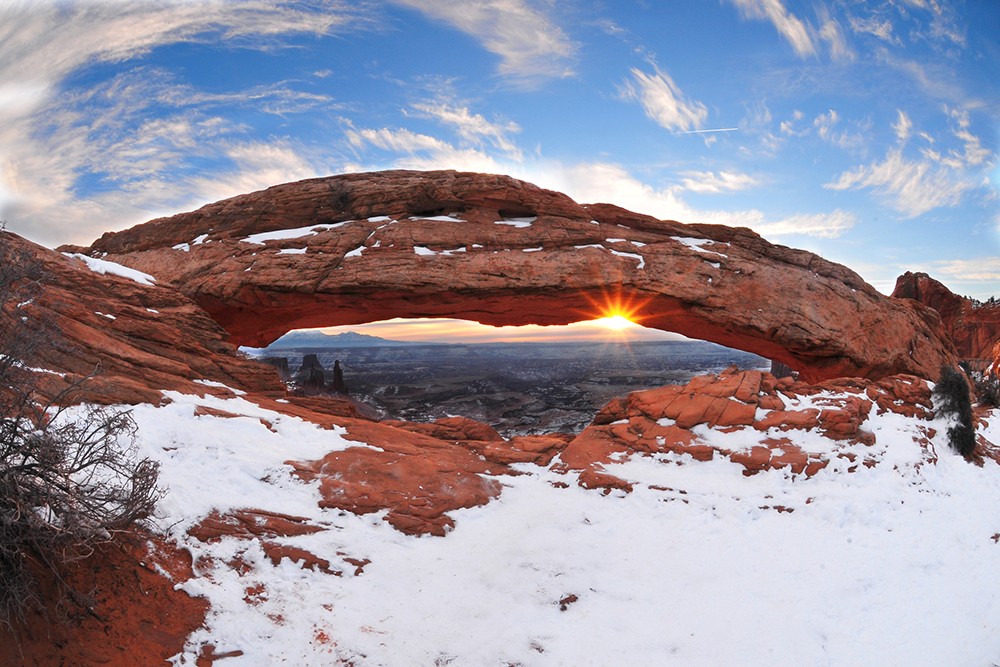
Canyonlands National Park
Winter is a great time to pursue an adventure to our majestic national parks and monuments.
Not only does the cold season bring out a glistening beauty all its own, but parks see their fewest visitors of the year so you and your family can experience wildness and solitude without the crowds of summer.
National Parks are more popular than ever, now that they are open and many people are traveling again. The colder season is an exceptional moment to visit; parks are well-equipped to welcome travelers in the winter-months.
Added bonuses are the discounted admission to the parks and bargain pricing that is often available at campgrounds or accommodations in the off-season.
Each park on the NPS.gov website features thorough information of attractions for planning your winter trip, as well as current road conditions and visitor center hours. The site has an interactive map for exploring National Parks near you and suggestions for activities in the frosty months.
Ready to beat the winter blahs with a surprising adventure in an unusual season? Check out these parks in your region and light up the dark months with an invigorating trip.
OUT WEST
Mount Rainier National Park, Washington
Close to the Seattle/Tacoma metroplex, this sleeping volcano rears its impressive 14,409 feet of height through the clouds over the city. Get a closer view of this seldom-seen wonder on a day trip or weekend in winter.
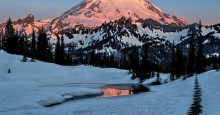
Mt. Rainier National Park
Besides rugged ice-climbing and trekking, family fun can be experienced on snowshoes, sleds, toboggans, skis and snowboards. Lower-elevation day-trip drives around the park give stunning views of the behemoth from the warmth of your car.
Redwoods National Park, Northern California.
Take a backroad trip through this park, bisected by busy Interstate 101, and slow down on the winding Redwood Highway through some of the tallest, most beautiful trees in the world. The soothing and serene quiet of the lush groves, the filtered light and water sparkling down from far above is enchanting.
Even in rain, the park has hiking trails and easy-access groves with sheltered picnic areas for walks at any energy level. Many accessible trails are provided, and self or staff-guided tours are featured at the visitors center.
Camping in the park is more available in winter; the public highway along the Eel River meanders through small hamlets with many restaurants or accommodations to choose from.
Pinnacles National Park, Central California.
A few hours away from the San Francisco Bay Area and close to Monterey Bay, this little visited site is a stunning geologic gem. An abundance of never to be forgotten trails wander through the other-worldly, towering volcanic rock pillars and caves.
The park actively helps preserve the giant California Condor and is a favorite of bird and wildlife enthusiasts. Vivid colors and dark tunnels are a feature of “short paths for the whole family to strenuous hikes for the true adventurer” shown on the website. Camping is available year round in the park; excellent hotels and restaurants are abundant nearby.
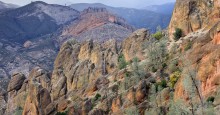
Pinnacles National Park
CENTRAL MOUNTAINS
Canyonlands National Park, Utah.
Want to feel really small against the “…vast distances where a lifetime of exploration awaits” as promised by the park website?
Close to the more popular Arches National Park near Moab, this park contrasts deep chasms with the surrounding high mesas of the Colorado River; a seemingly endless vistas of towers, monuments, and pillars against the immense backdrop of the Rocky Mountains. Dusted with snow like a many-layered cake, the canyons seem steeper, and the distances larger in winter.
Canyonlands has the smooth red rocks and arches that its neighbor is known for, but far fewer visitors. The park has four districts: Island in the Sky, The Needles, The Maze, and the rivers. There are hiking, snowshoeing and cross-country skiing trails for every level of stamina. Touring routes for longer distances or day trips are provided at the Visitor Center at Island in the Sky, which is open seven days a week.
Bryce Canyon National Park, Utah.
“Red Rocks, Pink Mountains and Endless Vistas” says the banner on the National Park Service site.

Bryce Canyon National Park
Amazing in winter is the magic of the hoodoos - the irregular racks and ridges of blunted pinnacles and striated colored cliffs. Bryce Canyon is home to the most hoodoos on earth; stunning in this season with range on range dusted with caps of sparkling snow punctuated by flocks of evergreen trees in the deep slot-canyons between them.
The Bryce Amphitheater remains accessible year-round, though some trails and nearby roads close seasonally. The website for the park has suggestions for typical winter visits of 1-3 hours and 4+ hours, with routes clearly laid out. Groomed trails for snowshoeing, cross-country skiing and winter hiking are enjoyed by every generation.
The Bryce Canyon Winter Festival and Christmas Bird Count are two popular annual events.
SOUTHERN PARKS
Death Valley, eastern California and Nevada.
Known for its breathtaking desert views, paintbox of vivid geologic colors, and high summer heat - in winter there is no trace of the scorching temperatures.
Explore sparkling, snow-dusted dunes towering over many walking trails. Beloved of off-roaders, the park has many routes of stellar views in the pleasant cold of winter.
“Half the park is after dark!” states the International Dark Sky Association.
There is no closing time at Death Valley; hiking trails are open and stargazing is a popular pastime, especially in winter.

Death Valley
For a fabulous loop route, drive north from Las Vegas through the “back door” of the park on the Nevada side, and travel Highway 190 west from the lowest point in the US to catching a glimpse of Mt. Whitney - the highest mountain in the lower 48 states.
Big Bend National Park, Texas
Many people think of the vast, flat plains of Texas and are unaware of the spectacular mountain scenery of the Chisos range in this park. Wide-open spaces meet impressive steep river canyons, pillars of tower-like mountains and lovely blooms of white-encrusted trees climbing the mesas for a wonderland in winter.
Peregrine Falcons soar in the sky, antelope herds cluster in the valleys and hot springs steam naturally from the ground. Gone are the whitewater rafters and climbers of summer for a true crowd-free experience. Even the campgrounds and hiking trails are big in this little-known Texas gem.
MIDWEST
Voyageurs National Park, Minnesota
Experience the northern lights and stargaze in the midst of stunning lakes, shores and islands crusted over in natural ice sculptures. The Aurora Borealis is often seen in winter in this little-visited park, with hundreds of miles of waterways and trails sheltered from Lake Superior.
Voyageurs National Park provides adventure year round for exposed rock ridges, cliffs, wetlands, forests, streams and lakes.
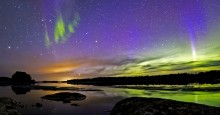
For the cold season, the site lists resources of private snowmobile tours, winter sports gear suppliers and guides for day trekking. If you wish to get away from the scenic roadways to enjoy this astoundingly beautiful park, trails abound for novice to expert hiking, cross-country skiing and snowshoeing.
The park’s website has guides for viewing the northern lights, specific trail updates and featured seasonal activities.
Ozark National Scenic Riverway, Missouri
“Where The Red Fern Grows…” conjures up glorious scenery and a paradise as described in a book famous in children’s literature; this park is that beauty and history preserved for the public. Miles of trails, roadways and rivers feature the unique cultural, historical and natural resources of the Current and Jacks Fork Rivers.
The park contains historic frontier communities, water-mills, first nation sites and abundant learning resources that showcase this jewel in the Ozark Mountains. According to the park website. Ozark National Scenic Riverway has the most natural springs in one area in the world, welling up from the karst geological deposits among the oldest rocks in the United States.
There is plenty for travelers–whether families or individuals–to do, learn and see.
EASTERN PARKS
Acadia National Park, Maine
This giant, ocean-punctuated peninsula is known as the “Crown Jewel of the North Atlantic Coast.”
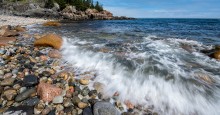
Acadia National Park
The site’s rugged scenery and accessibility make it among the most visited parks in the nation in summer, yet it is almost deserted in the winter months. The peninsula shelters the highest rocky headlands on the Atlantic, and is the historic home of immigrants as far-flung as Louisiana’s Cajuns and first-nation Wabanaki peoples.
Explore remnants of historic communities, lighthouses, amazing coast drives and rocky islands crowned with dense caps of trees. Watch for abundant wildlife and seabirds while observing historic fishing activity off the Atlantic coast.
Check conditions if you plan to drive the towering Mount Desert Skyway and meander over scenic routes through the preserve. Winter activities abound and hiking trails are groomed for every activity level. Camping is available in the park and nearby communities furnish accommodations and dining.
New River Gorge, West Virginia
Be refreshed with plunging views into the forests and steep river canyon that shelter historic railroads routes, mining sites, pioneer mountain communities and a gorge-spanning iron bridge that was the engineering wonder of its time.
In summer, the sharp bends of the New River abound with whitewater and boating excursions, but in winter the park gives a sense of the primeval forest and unexplored continent that confronted the First Nation peoples and European pioneers. The popular one-mile loop of the Castle Rock trail shows towering cliffs and exposed coal seams.
The breathtaking Grandview Rim route and Turkey Bend Overlook are sometimes closed due to freezing weather. Historic sites let visitors imagine the lives in mining and timber towns of people as diverse as log cabin pioneers or the legendary John Henry, born a slave and later earned a reputation as “the steel-driving man” of the Chesapeake & Ohio Railroad.
The park is chock-full of activities, history, learning and fun for everyone.
Copyright © 2024 by Sensible Driver. All rights reserved.



